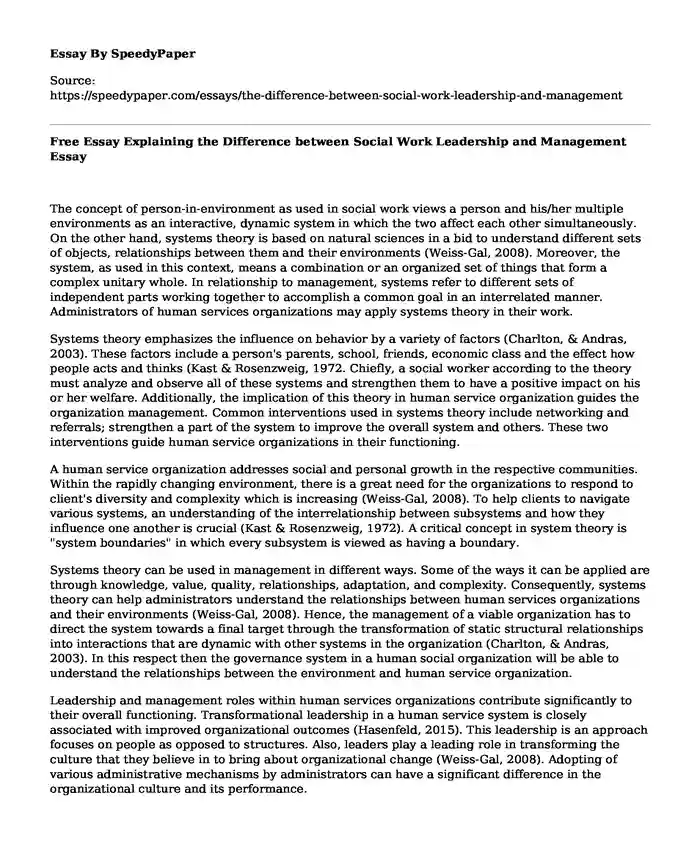
| Type of paper: | Research paper |
| Categories: | Leadership analysis Management Social work Human services |
| Pages: | 3 |
| Wordcount: | 636 words |
The concept of person-in-environment as used in social work views a person and his/her multiple environments as an interactive, dynamic system in which the two affect each other simultaneously. On the other hand, systems theory is based on natural sciences in a bid to understand different sets of objects, relationships between them and their environments (Weiss-Gal, 2008). Moreover, the system, as used in this context, means a combination or an organized set of things that form a complex unitary whole. In relationship to management, systems refer to different sets of independent parts working together to accomplish a common goal in an interrelated manner. Administrators of human services organizations may apply systems theory in their work.
Systems theory emphasizes the influence on behavior by a variety of factors (Charlton, & Andras, 2003). These factors include a person's parents, school, friends, economic class and the effect how people acts and thinks (Kast & Rosenzweig, 1972. Chiefly, a social worker according to the theory must analyze and observe all of these systems and strengthen them to have a positive impact on his or her welfare. Additionally, the implication of this theory in human service organization guides the organization management. Common interventions used in systems theory include networking and referrals; strengthen a part of the system to improve the overall system and others. These two interventions guide human service organizations in their functioning.
A human service organization addresses social and personal growth in the respective communities. Within the rapidly changing environment, there is a great need for the organizations to respond to client's diversity and complexity which is increasing (Weiss-Gal, 2008). To help clients to navigate various systems, an understanding of the interrelationship between subsystems and how they influence one another is crucial (Kast & Rosenzweig, 1972). A critical concept in system theory is "system boundaries" in which every subsystem is viewed as having a boundary.
Systems theory can be used in management in different ways. Some of the ways it can be applied are through knowledge, value, quality, relationships, adaptation, and complexity. Consequently, systems theory can help administrators understand the relationships between human services organizations and their environments (Weiss-Gal, 2008). Hence, the management of a viable organization has to direct the system towards a final target through the transformation of static structural relationships into interactions that are dynamic with other systems in the organization (Charlton, & Andras, 2003). In this respect then the governance system in a human social organization will be able to understand the relationships between the environment and human service organization.
Leadership and management roles within human services organizations contribute significantly to their overall functioning. Transformational leadership in a human service system is closely associated with improved organizational outcomes (Hasenfeld, 2015). This leadership is an approach focuses on people as opposed to structures. Also, leaders play a leading role in transforming the culture that they believe in to bring about organizational change (Weiss-Gal, 2008). Adopting of various administrative mechanisms by administrators can have a significant difference in the organizational culture and its performance.
In conclusion, systems theory guides social workers to assess factors that impact the individual in an organization. The person-in-environment approach views an organization as a system in which there exist subsystems that work together for a common role. Nonetheless, leadership and the organization play a prominent role in transforming the overall functioning of a human service organization.
References
Charlton, B. G., & Andras, P. (2003). What Is Management and What Do Managers Do? A Systems Theory Account. Philosophy of Management, 3(3), 3-15. doi:10.5840/pom2003332
Hasenfeld, Y. (2015). What Exactly Is Human Services Management? Human Service Organizations Management, Leadership & Governance, 39(1), 1-5. doi:10.1080/23303131.2015.1007773
Kast, F. E., & Rosenzweig, J. E. (1972). General Systems Theory: Applications for Organization and Management. Academy of Management Journal, 15(4), 447-465. doi:10.5465/255141
Weiss-Gal, I. (2008). The Person-in-Environment Approach: Professional Ideology and Practice of Social Workers in Israel. Social Work, 53(1), 65-75. doi:10.1093/sw/53.1.65
Cite this page
Free Essay Explaining the Difference between Social Work Leadership and Management. (2022, Jul 26). Retrieved from https://speedypaper.net/essays/the-difference-between-social-work-leadership-and-management
Request Removal
If you are the original author of this essay and no longer wish to have it published on the SpeedyPaper website, please click below to request its removal:
- With Competition Fierce - Article Analysis Essay Example
- Free Essay Example on Organizational Culture Theories
- Contrast Essay Sample: eBay's Original Business Model vs Its Current Business Mmodel
- Monetary Policy of Turkey - Finance Essay Sample
- Forms of Capital, Marketing and Consumerism - Paper Example
- Research Proposal Example - Parenting in America
- Free Essay Example: Exploring Natural Medicine for Anxiety and Depression
Popular categories




